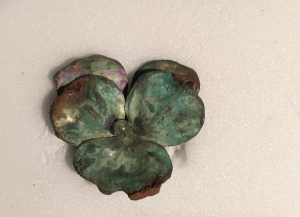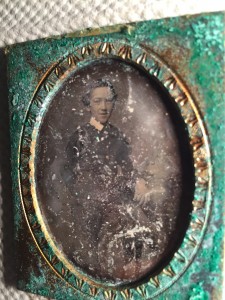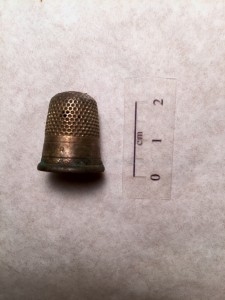In the course of this summer’s excavations on Cole’s Hill located in downtown Plymouth, Massachusetts, as part of the University of Massachusetts Boston’s multi-year archaeological project, Project 400, a group of archaeologists uncovered a mystery for the ages – a cache of intentionally buried personal items including jewelry, sewing items, and other finds. Some of these objects were mysteries in the field, and the most spectacular discoveries were made during careful conservation work in the lab.
As one of the five units laid out on Cole’s Hill, excavation unit 3 (EU3) was a 1 by 2 meter unit oriented north-south, placed in an area of Cole’s Hill that emitted a strong signal from the frequency domain electromagnetic (FDEM) survey. Thus, the archaeologists expected to find a large concentration of metal in this unit, which they did in the form of slag or furnace byproduct in the upper levels. However, beneath these top layers excavators Victoria Cacchione, Nadia Waski, and Laura Medeiros found an intentionally dug pit, partially edged and capped with cobbles. It was in this pit, in the northern part of the unit where the mysterious cache emerged.
A large, intact 25 cm long glass syringe started it all. Once the archaeologists excavated this unique artifact, they began to unearth more strange and exciting objects, many of them of a personal nature. The most thrilling of these were two daguerreotypes and two ambrotypes in leather cases, all stacked together with a braid of a woman’s hair secured on top with silk ribbon. Associated with these were six glass jewels of assorted colors. From the north wall, the archaeologists uncovered a fully intact buckle with a patent date of Dec. 15, 1885 attached to a rolled leather belt. Other artifacts included a shell cameo brooch, anchor pin, straight pin, a locket, two ebony rings, an ivory brooch, and a complete brooch and earring set. In addition to the artifacts from the north wall, the archaeologists also found that the bottom of the pit appeared to be lined with a number of pieces of fabric (at least three distinct objects) that sat directly above the sandy, light colored subsoil. The artifacts were not isolated to just the north wall; the archaeologists discovered several of the organic objects and personal adornment items below the cobbles, indicting that the cobbles partially covered the deposit but did not extend to the north wall. The artifacts unearthed near the cobbles included a small glass bottle, a pansy brooch, and a pair of spectacles encircled by layers of metal coils. These coils remain another mystery within this already peculiar cache.
One would think that all these magnificent, bizarre artifacts would be enough to keep the archaeologists and conservator occupied. Yet EU3 and the mystery cache produced even more artifacts to add to the riddle. Located along the western side of the unit, the archaeologists found more of the organic objects associated with a gold plated thimble, a bone object, and a number of mismatched buttons leading them to believe it was a sewing bag or kit. Upon further investigation in the lab, the conservator and the archaeologists discovered even more buttons, jewelry, and a broken key still attached to its key ring.
In total, this mystery cache contains over one hundred artifacts. The conservation and analysis of these artifacts remain on going. In subsequent blog posts, the archaeologists invested in this project will continually reveal more about the people associated with these incredible and unique artifacts. The research will hopefully answer questions regarding whose belonging these were, the identities of the people in the daguerreotypes and ambrotypes, the circumstances that possibly lead to the deposition of these extremely personal objects, and the use and meaning of the artifacts. The posts will also bring attention to the importance of respectfully excavating, conserving, analyzing, and displaying such items of personal meaning.







